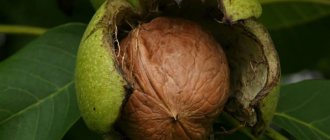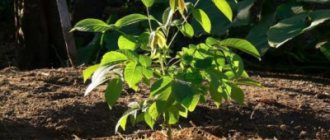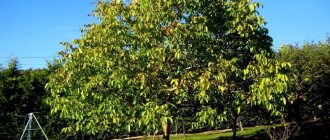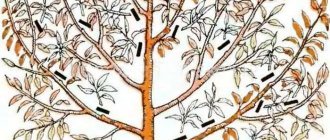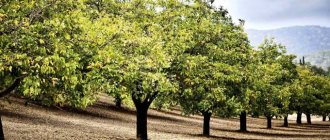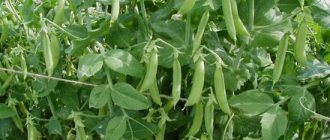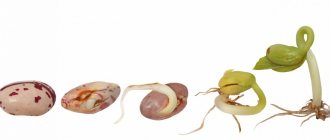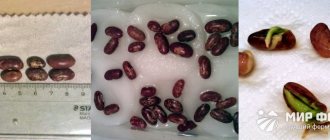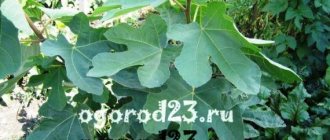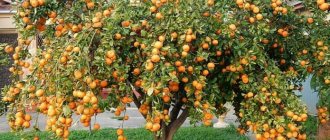Why germinate walnuts
Walnuts can be grown using vegetative and generative methods.
The second option involves using a plant seed, i.e. the nuts themselves. Their shell is thick and durable, so under natural conditions the fruits have low germination. Often the core rots before the shell opens.
Unsprouted nuts can be planted directly in open ground. This is done in the fall, immediately after the fruit falls from the tree. In this case, you will have to use a large amount of planting material, since a small percentage will be able to germinate on their own.
Experienced gardeners recommend first preparing and rooting the nut at home. After the shell opens, the sprout hatches and gets stronger, it is planted in a permanent place.
How do you know when it’s time to transplant seedlings into the ground?
Advice
Healthy, strong seedlings that have reached a height of 20-25 cm can be transplanted into open ground.
With a little effort and patience, you can germinate nuts yourself, which means that in the future you can grow a seedling and the tree itself. It must be remembered that in most cases the grown plant will not be similar to the mother tree, but this does not mean that the variety bred by the gardener will be worse than the previous one.
Article on the topic
All methods of walnut propagation.
Selection of nuts
For successful germination, it is important to choose suitable planting material.
Pay attention to the following signs:
- Variety If the nut is grown as a houseplant at home, any variety will do. If you plan to plant a plant in open ground, preference is given to zoned varieties that are comfortable in the local climate.
- Weight. The nut should be heavy. If it is light, then the kernel has dried out or rotted.
- Shell thickness. It is easiest to germinate fruits with thin shells.
- Appearance . Fruits with intact shells are suitable. Instances with holes, dark and moldy spots, or rotten areas cannot be used.
Nut fruits no more than a year old are suitable for planting. The older the planting material, the lower its germination rate.
Dried, heat-treated nuts are not suitable. The kernels inside them are non-living, so they will not germinate.
Store-bought nuts are usually dried, and to give the shells a lighter shade, they are soaked in a chlorine solution. Therefore, it is better to collect the seeds yourself.
Advice. Planting material capable of germinating can also be purchased from private traders on the market.
Walnuts are collected when they begin to fall from the tree. Many gardeners believe that it is best to pick fruits from the branches.
Preparation
Before germinating a walnut at home, it is prepared. This process consists of the following steps:
- Peeling. The green soft part is completely removed. They do this with gloves, because the iodine contained in the shell stains the fingers. It is important not to damage the hard shell.
- Germination test . The peeled fruits are immersed in warm water. Those of them that do not drown in half an hour are not suitable for landing. The specimens that have sunk to the bottom have a dense, heavy, intact core, so the chances of their germination are high.
- Disinfection. The nuts are dipped in a light pink solution of potassium permanganate for half an hour.
- Stratification. Planting material is buried in a box with wet sand and removed to a place with a temperature of 0 to +5°C. So the nuts should last 3-4 months. All this time, the sand is moistened and ventilated every 2 weeks.
- Examination. Before planting, the shells are inspected for mold, dark and light spots, and damage. The nuts are again immersed in water and the specimens that have sunk to the bottom are left for planting.
Stratification is a mandatory stage in preparing walnuts for planting. During this procedure, conditions close to natural are created when the fruits germinate. Thanks to this, the nut ripens, its shell becomes thinner, and sprouts appear soon after planting.
Note! Some gardeners include calibration in the list of preparatory work. It is believed that larger nuts germinate faster, and the trees subsequently produce larger fruits.
Preparing for landing
There are many ways to germinate walnuts, and here is one of them. After the fruits have been selected, they should be placed in a container, the selected kernels should be laid out in one layer and sprinkled with damp sand or sawdust, which are ideal for germinating seeds. It is better to use a regular cardboard box as a container.
Interesting!
A seedling is a young plant grown from seeds. A sapling is a woody plant grown from a seedling or cuttings.
The container with the seeds of the future walnut tree should be placed in a dark and cool place, the temperature conditions of which do not exceed 0 - 5 C. Now all that remains is to wait. It is not difficult to germinate a walnut; it will be ready for planting in 4-5 months. But that is not all. The container with growing walnut tree fruits needs to be ventilated every 3 to 4 weeks, just like the sand should be moistened.
After this preparatory period of time, the walnuts finally ripen as seeds and can be planted in previously prepared soil. The best time to plant walnuts is mid-spring, namely mid-April.
The pot for the future seedling also needs to be chosen wisely. A spacious plastic or clay pot, more than 30 centimeters deep, is perfect for this. You can also build a wooden tub for it yourself. A pot depth of 35-50 centimeters will be enough for the proper development of the root system of the future tree.
How to germinate them correctly
If in the open ground nuts begin to germinate in the autumn, then at home this is done in the spring after stratification. There are different ways to plant plants in an apartment.
Different ways
Most gardeners believe that it is easiest to germinate a nut by planting it directly in a pot of soil. To do this, use a plastic container, a wooden or clay tub about 30 cm deep. The container is filled with a soil mixture prepared from:
- 3 parts peat,
- 3 parts garden soil;
- 1 part humus.
The components are mixed and calcined in the oven or poured over with a dark pink solution of potassium permanganate. The planting container is doused with boiling water or soaked in a strong solution of potassium permanganate.
Important! There must be drainage holes in the bottom of the planting container.
For planting, you will need drainage, for example, crushed bricks, small crushed stone, broken ceramics, coarse sand, or special purchased drainage for plants. It is also disinfected.
Step-by-step planting instructions:
- The pot is filled with a layer of drainage no less than 5 cm high. The rest of the volume is filled with soil.
- Planting material is planted in individual containers to a depth of 7-9 cm. The nut is laid on its side.
- The soil is watered generously with water at room temperature. Some gardeners add a growth stimulant (“Epin”, “Kornevin”, “Rastvorin”) to the water during the first watering.
- Cover the container with film and put it in a warm, bright place. The soil is watered as it dries. To prevent mold from forming, it is ventilated.
After germination, the nut begins to harden. To do this, open the film slightly, gradually increasing the time of such ventilation. Then it is completely removed.
You can germinate nuts in water. This is done at the end of winter or beginning of spring, when the heating is still working. For this:
- Fill the jar one third with warm water. A nut is placed in it, sealed with a lid and placed on the battery. The planting material is left in this form for 2-3 days. During this time, it should be saturated with moisture, and the shell flaps should open slightly.
- After 3 days, all the water is poured out of the jar. 0.5 cm of warm water is poured into the bottom of the container, then planting material is placed in it. The lid is left slightly open to allow air circulation. After 10-14 days, a sprout should appear and grow.
- Together with the shell, it is transplanted into a container with soil so that the regrown part is above the surface of the soil. Keep the plant in a warm, bright place and water as needed.
Green (unripe) walnuts, which are used to make jam, are not suitable for planting. Its core is not yet formed, so it will not sprout.
Care during germination
In order for the sprouts not only to look, but also to be healthy and strong, to take root well after planting in open ground or a large container, it is important to properly care for them and provide optimal conditions:
- Lighting. A light-loving walnut tree, even at the stage of growing a seedling, must receive enough light. It is best to keep it on a south or west windowsill. If this is not possible, use fluorescent lamps.
- Temperature. The tree does well at room temperature. If it is warm outside, be sure to ventilate the room.
- Hardening. The walnut tree begins to be taken outside when the air temperature reaches +15°C. The plant is brought in at night. In the summer, when the nights are also warm, you can leave the nut overnight. Then the plant will easily survive transplantation into open ground. It is also useful to take indoor nuts outside.
- Watering. The sprouts are watered as the soil under the root dries. It is important that the soil does not dry out, but that the moisture does not stagnate.
- Mulching. In order for the tree to form a strong root system that quickly adapts to new conditions after transplantation, its base is mulched with peat.
- Feeding. Complex fertilizers containing potassium are applied once every 2 weeks. For sprouts, use a concentration of half the norm.
Seedling care
Caring for a seedling is not difficult; the main point to remember is the plant’s watering schedule. The main thing is not to flood the seedling, as this can lead to rotting of the fruit in the soil, and all the effort spent will be wasted. Also, if there is a lack of moisture in the pot, the seedling’s ligature will not be formed correctly, and in the worst case, the plant will simply dry out. So for your own convenience, and to avoid the death of the plant, you should draw up a watering schedule.
Also important factors in growing a healthy plant that can bear fruit in the future are sufficient lighting, sunlight and sufficient fresh air are desirable. If possible, at a temperature of +15 C or more, the seedling should be taken outside for its own benefit. The seedling should be protected from overheating; one way can help with this: you should wrap the pot with the plant in a rag moistened with plenty of cold water. A gusty wind or even a small draft can cause enormous damage to a plant.
It should be remembered that you will need to loosen and saturate the soil at the base of the seedling with peat and fertilizer containing potassium, approximately once every two weeks. You also need to protect the plant from harmful bugs, especially during hot periods, since the plant will mostly be outdoors.
It is important to keep in mind that at first the tree has not yet formed, so it will be necessary to mold its crown and remove flowers if they appear. This must be done so that the seedling does not waste the received nutrients on growing fruit that is now unnecessary, and all the vitamins obtained from the soil go into the growth of the tree. In summer, when the tree is at its peak, thin and weak shoots of young nuts should be removed. Growing walnut trees is not at all difficult if you follow the tips in this article.
How to plant sprouted nuts in the ground
The seedling is planted in open ground a year after sowing. By this time he will have become stronger in order to take root in new conditions . Planting work is carried out in the spring, when the outside temperature reaches +15°C.
It is important to choose a suitable place to plant the seedling. The walnut tree is growing rapidly. Therefore, it is placed at a distance of at least 6-8 m from buildings and 3 m from other trees.
Groundwater should not lie closer than 1.5-2 m, since the plant has a powerful taproot system. The soil is preferably neutral or slightly acidic.
The site is prepared for planting in the fall. It is dug up and cleared of weeds. The soil is mixed with fertilizers. To do this, 6 kg of humus, 35 g of superphosphate, 30 g of potassium fertilizer, 30 g of ammonium nitrate are scattered on every 1 m². The soil is dug up again.
In spring, the soil is cleared of new weeds and leveled with a rake. Dig a hole 60 cm deep and 40 cm wide. Pour a hot solution of copper sulfate into it (1 tablespoon per 1 bucket of water). The soil removed from the hole is mixed with a bucket of humus and 1 kg of ash.
10 cm of drainage is poured into the bottom of the hole, and 5-10 cm of nutrient soil mixture is placed on top. Then the walnut removed from the pot is placed along with a lump of earth. The rest of the volume is filled with soil. The plant is watered and the missing soil is added, which should not cover the root collar. The tree trunk circle is mulched.
Seed germination
2-3 weeks after sowing, the top layer of soil is carefully removed without touching the nuts to check their germination. If the shell flaps separate and a small white root appears, then the seeds have sprouted. For further cultivation, the container is moved to a sunny window, where the growing of seedlings continues until they are transplanted into open ground.
It should be borne in mind that the timing of seed germination cannot always be predicted. Fresh and high-quality planting material can germinate in just 10-12 days, while seeds purchased in a store sometimes require 1 to 6 months. The germination rate depends on the time of seed collection and storage conditions, and these indicators are often simply unknown.
For example, a seed that fell in the fall and ripened naturally without additional stimulation with growth preparations sprouts in open ground only in May. Artificially planted nuts germinate in containers within the second week.
Further care
A young tree needs more care than an adult one. Be sure to follow the following rules:
- Watering. The young plant is watered every 2 weeks. For 1 m² use 4 buckets of water at room temperature. The soil around the nut should not be allowed to dry out; it is important to ensure that there is no stagnation of moisture. If you water the nut more than once every 14 days, it will be less able to withstand winter cold weather.
- Feeding. If enough fertilizer was applied during planting, there is no need to feed the tree for the first 3 years. Then nitrogen fertilizers are applied every spring, and phosphorus-potassium fertilizers are applied in the fall.
- Trimming. It begins to be carried out from the second year after disembarkation. In the process, a crown is formed, weak, damaged, dry branches are removed. The procedure is carried out every year.
Optimal conditions for growing walnuts at home
When growing an indoor walnut tree, it is important to create optimal conditions:
- The plant should be on a south or west windowsill. In winter, it is recommended to take the nut out onto the balcony.
- Room temperatures are suitable for growing a walnut tree, but higher temperatures are also favorable. In winter, you need to provide the nut with a state of rest. To do this, it is taken into a room with a temperature no higher than +12°C.
- Water the nut about once a week. Do not allow the soil to dry out or become stagnant.
- The tree is fed in the same way as a street nut. Nitrogen fertilizers are applied in the spring and phosphorus-potassium fertilizers in the fall.
- When the plant reaches the desired height, pinch off the top. The crown is formed by removing excess, weak and inward-directed shoots. All damaged and dry parts are also cut off.
- In winter, no fertilizing is applied; the plant is watered less often.
Planting a plant
The planting scheme can be divided into several steps . It will then look like this:
first of all, pour a drainage layer into the planting container, filling about a third of the volume;- then the soil mixture is filled in;
- then the nut is deepened into the ground by about 7-9 centimeters, placing it on its side;
- water the seedling abundantly;
- The pot is left in a warm place with sufficient light. It can be covered with film or glass on top to create a greenhouse effect.
The sprouts should hatch after about 2 weeks. After this, it is necessary to provide the plant with proper care in order to obtain a tree that bears fruit in the future.
You can try to germinate walnuts for planting in a glass, but when the seedlings reach a height of about 10 centimeters, they will need to be transplanted into a larger container.
Basics of seedling care
For normal growth and development of the plant, it should be provided with proper care. It consists of regular watering and following some simple recommendations. If they are carried out, growing walnuts will not cause much trouble. Basic care requirements include:
- Lighting. This tree is a heat-loving crop, so it begins to grow worse in the shade. This must be taken into account when choosing a place for it.
- Watering. It should be regular and plentiful. However, the water should not stagnate. Stagnation of water can cause the root system of the plant to rot. And if there is not enough moisture, the ovary will begin to form incorrectly.
- During the warm season, fresh air is very important. If the air temperature exceeds 15 degrees, then the seedlings can be placed outside, choosing a sunny place. However, you need to ensure that the plant does not overheat. To do this, you can wrap the pot with a wet cloth. You also need to ensure that there are no drafts or sharp gusts of wind.
- At the base of the trunk you can mulch the soil.
- Once every two weeks, the seedling is fed with a complex type of fertilizer, which contains potassium.
- In the warm season, the tree must be protected from insect pests, because at this time it is outdoors most of the time.
If you plan to grow the walnut in a container at home in the future, it should be replanted annually until it reaches four years of age. In this case, each time you should choose a container larger in volume than the previous one. Also, each time you need to cut off a third of the root system. After the tree reaches the age of four years, it requires replanting approximately once every five years. Every year you just need to add a little fresh soil.
When growing a walnut tree at home, it will require pruning. A crown is formed in the spring and sanitary pruning is carried out, removing old and weak shoots.
Transplantation to a permanent place
If the tree is planned to be grown in open ground, then it is best to plant seedlings a year after planting. The time for this is chosen after the night frosts have subsided, that is, in April-May. During this time, the seedlings should grow to 20 centimeters.
The first thing to do is prepare a place for planting . It must be remembered that the plant loves light and sun, so there should be no tall shading objects nearby. Then you should prepare a hole for planting. Its depth should be approximately 1 meter. It should be fertilized with manure mixed with superphosphate and wood ash.
Then the seedling should be carefully removed from the container so as not to damage the root system, and the tap root should be cut by a third. This procedure will promote the development of lateral roots. When planting in the ground, you should ensure that the root collar is 3-4 centimeters above it. After placing the seedling, the hole should be filled with the remaining soil, compacted well and watered properly. To avoid accidentally damaging or breaking the plant, it is better to tie it to a wooden peg. Here's what you need to know about how to germinate a nut and further care for it.
When will the nuts begin to bear fruit and what is needed for this?
The nut begins to bear fruit 7 years after planting. Typically, a tree grown generatively does not retain its maternal characteristics. Grafting with cuttings or buds taken from an already fruit-bearing tree of a suitable variety will help eliminate this problem and increase yield.
This is interesting:
Eating walnuts for weight loss: is it possible to eat and in what quantity?
How to properly preserve fresh figs so they don’t spoil
Storage of planting material
If you are not planning to plant nuts in the fall, you can save the seeds until spring. To do this, they are buried in a container with moistened sand and left for winter storage in a dark and cool place, for example in a cellar or basement.
About a month before the May planting, the nuts are transferred to a soil mixture prepared for germination, consisting of thermally treated sand and sawdust and sprinkled with a growth stimulator. The container is taken out to a bright and warm place.
Winter storage of nuts in sand prevents the kernels from drying out, the shells cracking, and the formation of mold and parasites. When stored in plastic bags, all this cannot be avoided.
Germinated seedlings can be transplanted into open ground in May or grown in a container until autumn and planted in October. If seedlings are grown indoors for a long time, they must be transplanted into large diameter containers twice a season.
Seedlings grown in spring must be hardened off before planting in the ground. To do this, they are taken outside every day for several hours. Gradually, the time spent outside should be increased, reaching full daylight hours.
Collection and storage of fruits
The fruiting period for walnuts is September. You need to pick fully ripe fruits - they are much healthier and last longer. Their maturity can be determined by such signs as cracked shells, friability and yellowing of the outer shell (photos of ripe fruits can be found on Internet resources). Most of the nuts fall off on their own, but to remove the rest, you can shake the tree or use an apple picker.
Important! Nuts that have fallen off themselves must be collected from the ground as soon as possible, preferably
on the same day , otherwise mold will begin to develop in the kernels.
After harvesting, the nuts need to be cleared of any remaining skin. If you come across dirty fruits, they are washed first. Next, it is advisable to spread the harvest on paper and dry it in the fresh air, after which final drying is carried out in the oven at a temperature not exceeding 90°C. Prepared nuts can be shelled and eaten or stored in a vacuum bag in the refrigerator for up to 1 year . Unpeeled fruits are stored in nets or cardboard boxes at home in a dry, ventilated area, where they can safely lie until the next harvest season.
Growing walnuts from nuts is one of the common methods of propagating the plant. This procedure eliminates the need to purchase expensive seedlings. Don’t forget to take care of the plant, creating good conditions for it: years later it will definitely thank you with good fruiting, because one tree can produce up to 80 kg of tasty and healthy nuts.
Hazelnut stratification
Before sowing hazelnut seeds, they must be stratified for 3–4 months.
This process is carried out in the following way:
- You need to prepare a low wooden box with holes in the bottom.
- Pour wet sand into the container.
- Soak the nuts in water for about 5 days in advance.
- Mix the fruits with sand in a ratio of 1:3.
- During the entire stratification period, nuts can be mixed once every 10–15 days.
- It is recommended to keep the container with hazelnuts at a temperature of +2° to +6°C in the basement, on the balcony or in another cool place.
Where is the best place to plant a nut?
When you plan to plant a nut, you should pay attention to choosing the place where the tree will grow. It must be taken into account that it grows over a large area and stretches upward. The tree should not become an obstacle to the house or other trees. Experienced gardeners advise planting the nut away from buildings, as it has a large rhizome.
Over the years, it will begin to increase, which can damage the foundation. It is recommended to plant bushes near the nut. The young tree will not disturb them. Only after 7-9 years do the bushes need to be removed, as the nut will become quite large. So, germinating walnuts is a simple procedure. The main thing is to stick to simple rules.
Walnut budding on video:
Preliminary preparation
In order for a tree to bear fruit and develop well, it needs to be provided with suitable conditions. It all starts with choosing a location on the site. You should also take care of the soil. If you plan to plant a tree in the spring, then in the fall you prepare a hole 50x50 cm and 1 m deep. It is filled with fertile soil, compost, and humus. Periodically, this soil is loosened.
Choosing a location on the site
Voloshsky nut is a light-loving tree and a perennial plant, so you need to carefully choose a place for it. This should be an area that is very well lit by the sun and warms up quickly in the spring. Walnut must be planted separately from other trees and tall shrubs so that they do not darken the young seedling. You can plant nuts near raspberries and gooseberries. The distance to the nearest trees should be about 10 m.
The tree cannot be grown in areas with groundwater close to the surface. You should not plant nuts near small buildings, otherwise powerful roots can warp the building and damage its foundation. The nut has a rather spreading crown, so only shade-tolerant crops can grow next to it.
Also, the nut does not like drafts or strong winds, otherwise the buds will quickly be knocked off the tree by gusts of wind. Neutral or slightly acidic soil is suitable for it. Favorable types of soil for Volosh nut are any black soil, gray forest or sandy loam substrates.
Voloshsky walnut does not like waterlogging, so you should not plant it in an area where groundwater is located close to the surface.

